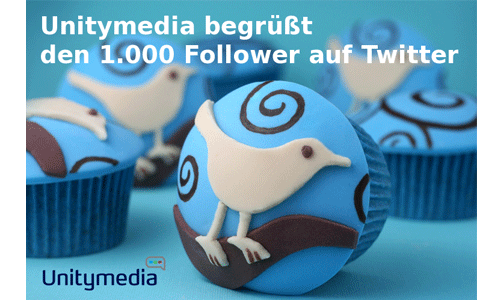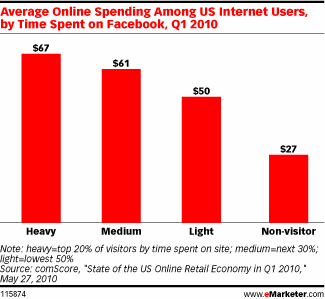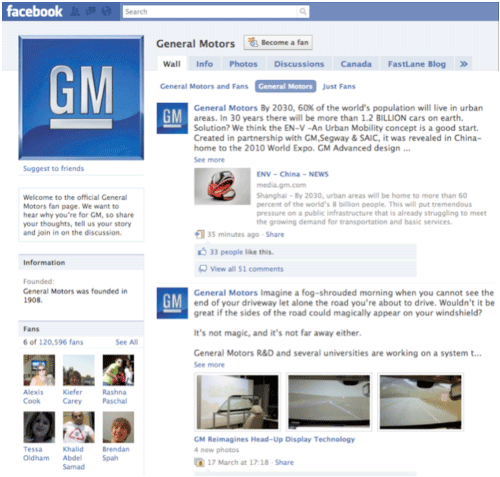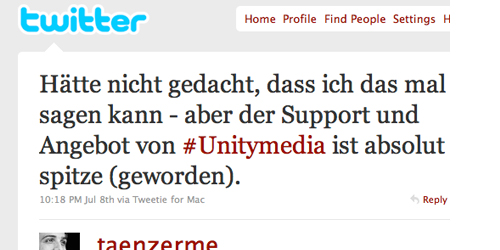So, oder so ähnlich, könnte eine Pressemeldung zum heutigen Tag aussehen.
Vor gut 4 Monaten haben wir zusammen mit unserem Kunden Unitymedia in einem Workshop den Grundstein in Sachen Social-Media-Strategie gelegt und sind mit Twitter gestartet. In erster Linie beantwortet das Social-Media-Team Kundenanfragen zum Produktangebot und kleineren technischen Problemen und informiert über Neuigkeiten aus dem Unternehmen. Heute, 20 Wochen nach dem Startschuss, gibt es einen wahren Grund zu feiern: Unitymedia begrüßt den 1.000 Follower auf Twitter.
Unitymedia macht wohl einiges richtig und holt den Konsumenten dort ab, wo der Schuh drückt: In seinem gewohnten Umfeld. Und all das mit kompetentem Service, schnellem Support und unkompliziertem Auftreten. Es ist also gar nicht schwer, im Social Web eine gute Figur zu machen. Alles was man dafür braucht: ein paar einfache Verhaltensregeln einhalten. Gemeinsam mit den Konsumenten und Kunden.
Daher schlagen wir vor: Unitymedia führt einen neuen Feiertag am 15. September ein, um an die gute Leistung des Twitter-Teams zu erinnern und weiterhin Ansporn für guten Service & Support zu bieten.

Bildquelle: Flickr.
Social Media
Es gibt 42 Beiträge in Social Media.
Was wir von Google Me erwarten können
Als Googles große Schwäche gilt, Orkut und Buzz zum Trotz, das Thema Social Media. Und als Lösung ausgemacht scheint seit geraumer Zeit das sagenumwobene Google Me. Handelt es sich dabei um eine Copycat von Facebook oder benutzen wir gar Google Me schon längst, ohne es zu wissen?
Aufschluss darüber, wie Google die Sache sieht, gibt ein Vortrag von Paul Adams, den dieser im Juli gehalten und den Gina Trapani jetzt ausgegraben hat. Paul Adams ist User Experience Researcher bei Google und referiert auf sage und schreibe 224 Seiten über das „Real Life Social Network“.
Paul Adams beschreibt einige Probleme und das gängige Nutzerverhalten auf heute existierenden Social-Media-Websites und macht Vorschläge, wie das Nutzererlebnis besser zu gestalten wäre. Das größte Problem für Nutzer sieht er heute darin, dass bei Facebook & Co. alle „Freunde“ in einem großen Topf landen, während im echten Leben verschiedene Gruppen von Beziehungen auch ganz verschiedene Interaktionsmuster mit sich bringen.
Jede Menge Hintergrundmaterial zu seiner Präsentation hat Paul Adams hier publiziert.
Unitymedia twittert und gewinnt!
Die Social Media-Plattform Twitter gewinnt im Kundenservice immer mehr an kommunikativer Bedeutung hinzu. Den Unternehmen bietet sich eine Vielfalt an neuen Möglichkeiten für einen unkomplizierten, aktiven und schnellen Austausch mit ihren Kunden.
Der Kabeldienstleister Unitymedia aus NRW und Hessen nutzt diese Chance bereits sehr erfolgreich. Die Service- und Pressemitarbeiter von Unitymedia wurden dafür von SinnerSchrader durch einen Strategie-Workshop geschult. Seit Anfang Mai twittern nun täglich vier Mitarbeiter Neuigkeiten aus dem Unternehmen und der Branche.
In erster Linie leistet Unitymedia hier gute Arbeit in Sachen Kundenservice und -zufriedenheit und beantwortet Fragen oder klinkt sich in vorhandene Diskussion clever ein. In kürzester Zeit war die Resonanz auf die Twitteraktivität überwältigend.
Für Follower ist der Unitymedia-Auftritt durch Sonderaktionen, wie dem Gewinnspiel „4 Player – 4 Tage“ am 13. Juli noch attraktiver geworden. Bereits am 1. Gewinnspieltag hat Unitymedia 150 neue Follower dazugewonnen. Nach dem erfolgreichen Start arbeiten Unitymedia und SinnerSchrader jetzt an einer Ausweitung der Social Media-Strategie.
Alex Bogusky sucht eine neue Herausforderung – außerhalb der Werbung
Werber-Ikone Alex Bogusky verlässt nicht nur die Agentur, die seinen Namen trägt. Er kehrt auch gleich der Werbung insgesamt den Rücken.
„I don’t think I’ll do much advertising“, sagte er der New York Times. „I’ve done plenty of it; I’m not able to find challenges in it.“ Er sucht also eine neue Herausforderung, und die findet er vor allem in jener Revolution, die den Konsumenten an die Macht gebracht hat.
Mostly, what I want to do is participate in this cultural revolution that’s happening mostly outside of advertising. The more interesting stuff is coming from the fringes, and that’s where I want to be. Social media is a fun place, and an amazing tool that’s making it more possible to reach consumers without the budgets because you don’t need the money now that was once required to reach them through ad campaigns.
Der Abgang von Alex Bogusky ist ein schwerer Schlag für die Werbebranche insgesamt, bezieht sie doch ihre Strahlkraft für den Nachwuchs nicht zuletzt von charismatischen Figuren wie ihm. Ambitionierte Berufseinsteiger, um die sich Agenturen reißen, suchen Herausforderungen – und finden die heute weniger in der Werbung als vielmehr in der digitalen Welt, meint Matthias Schrader:
Die klassische Werbeagentur ist tot, genauso wie die klassische Kampagne. Marken brauchen eigene Plattformen für den kontinuierlichen Dialog mit dem Konsumenten, für Interaktion und E-Commerce. Solche Plattformen können nur Agenturen liefern, die den Konsumenten in die Mitte ihres Denkens und Planens stellen – und nicht die Marke, das Produkt oder die geniale Idee.
Das Ende der Microsites? Oder gleich der Websites?
 Volkswagen bewirbt den neuen Polo GTI nur noch in Facebook. Keine klassische Werbung (das freut uns), aber auch keine Microsite – der Link von volkswagen.de führt direkt ins Reich von Mark Zuckerberg. Das beunruhigt womöglich. Die Älteren unter uns erinnert das an Zeiten, als AOL das war, was heute Facebook ist.
Volkswagen bewirbt den neuen Polo GTI nur noch in Facebook. Keine klassische Werbung (das freut uns), aber auch keine Microsite – der Link von volkswagen.de führt direkt ins Reich von Mark Zuckerberg. Das beunruhigt womöglich. Die Älteren unter uns erinnert das an Zeiten, als AOL das war, was heute Facebook ist.
Und Volkswagen ist nicht einmal Trendsetter. Coca-Cola hat schon Anfang des Jahres seine Kampagnen-Microsites zugunsten von Facebook und YouTube aufgegeben. Unilever geht in die gleiche Richtung.
Wird das alte Versprechen des Webs, das Marketing aus der Push-Ecke herauszuholen und es ins Gespräch mit den Konsumenten zu bringen, nun ausgerechnet von Facebook eingelöst? Mark Zuckerberg lässt sich von dieser Vision nicht erst seit gestern leiten. Auf Facebook-Seiten und in Facebook-Anwendungen geht heute schon vieles, wofür es bis vor kurzem noch eine eigene Website brauchte.
Wenn Facebook erst einmal alles kann, wofür dann überhaupt noch eine Website? Auf die ja erst einmal Traffic kommen muss, eingekauft mit viel Geld, das an Leute wie Matthias Ehrlich fließt. Der Traffic ist bei Facebook wahrscheinlich auch nicht umsonst, aber die Konsumenten haben dort, anders als im traditionellen Web, Gesichter und bringen ihre demografischen Daten mit.
Mark Zuckerberg verfolgt zudem eine Doppelstrategie: Wenn die Websites nicht zu Facebook kommen, dann kommt Facebook zu ihnen. Der Like-Button und die übrigen Social Plugins sind nur der Anfang.
Man muss weiterdenken. An das Ende der Website nämlich. Denn welcher Kunde will sie wirklich, diese Flash-Friedhöfe aus Pressemitteilungen und Broschüren? Er will sich vielmehr heimisch fühlen. Er sucht eine digitale Heimat, er will sein digitales Dorf. In diesem Dorf ist noch niemand Bürgermeister geworden, der nur Plakate geklebt hat. Wer regieren will, der geht von Mensch zu Mensch, von Haustür zu Haustür, von Kneipe zu Kneipe, dorthin, wo „gequatscht“ wird.
Facebook and Twitter Users Spend More Online
Need a reason why you should invest in a brand presence on Facebook or Twitter? Have a look at this research recently published by Comscore. According to their findings, heavy users on Facebook and Twitter spend more money online than average users.

Comscore defines heavy users as the top 20 per cent of visitors by time spent on the site, medium users as the next 30 per cent and light users as the lowest 50 per cent. The average e-commerce spending per visitor increases in correlation with the Facebook usage. Compare the numbers with the average Internet user who spent slightly less than 50 US-Dollars in the first quarter of 2010. Or, as eMarketer puts it:
Notably, Internet users who did not visit Facebook at all bought significantly less online than average, spending only $27 during the quarter. Not only are retailers on Facebook targeting above-average spenders, but the audience missing from the site is also worth much less in revenues.

On Twitter, we see a different picture, with even higher average spendings, but without a linear correlation between Twitter usage and spendings. What Facebook and Twitter users have in common is that they spend more money online than non-users.
Please note that these figures apply to the US market. Don’t know if there are similar figures available for Germany or Europe.
Hat tips to eMarketer and s2planning.
Tinypay.me is an Online Shop in a Nutshell
Tired of Ebay? Looking for a simple and do-it-yourself, social-media-enabled e-commerce solution? Then you should check out Tinypay.me. With Tinypay.me, you can create quick listings for your product or service, put it online and just sell. Nothing more then name, price and description is needed, you can even do without a picture (of course you shouldn’t).
Other options include donating the resulting money to charity, and name a location for your product or service in case that’s relevant. Share your listing on Facebook, Twitter and Google Product Search or integrate a simple shop on your blog or website. That’s all. Payment service is provided by Paypal, without other options.
Tinypay.me is amazing because of its simplicity. The whole setup is so easy and straightforward that it can be done in just one minute or even less. The downside is of course that the service lacks many features you might want to use, for example ratings for products and sellers. But their roadmap look promising, with features like an API on the way.
As Tinypay.me launched last February, the service itself isn’t yet a marketplace like Ebay, Etsy or Amazon with a huge audience of potential buyers. But if you already have your own audience on Facebook, Twitter, your website or blog, Tinypay.me maybe just the tool you need to sell something to the people that follow you.
But, and that’s a huge „but“, as Tinypay.me takes a five per cent commission (and Paypal deducts another chunk of your money), you need to stomach that. In many cases Ebay or Amazon might still be the better choice, taking less money and bringing in huge amounts of potential buyers, even though the selling process is not as easy as with Tinypay.me.
Hat tips to Denkzelle and Mashable.
The Social Media Guru
Laurent hatte mich schon letzte Woche auf dieses köstliche kleine Kunstwerk aufmerksam gemacht. Aber irgendwie war es dann wieder untergegangen, bis es Jochen Mai gestern in der Karrierebibel brachte. Pflicht für alle Socialmediaberater und solche, die es werden wollen.
Please behave in the Social Web: Talk about your Consumer, not about yourself!
Anyone knows the situation? It is Saturday evening and you go to a friend’s party. In Germany where I live they have stand-up parties where one stands the whole night in conversation holding oneself on a glass of beer. And then you meet a person talking only about one thing, about oneself. Difficult to escape and bad vibrations come.
What if the person talking about himself is a brand and the listener a consumer. This is what happens too often in the web. Back from the M2C Social Media conference in Paris here is my major take out: „Dear Brand, talk about the consumer, not about yourself!“
The M2C conference had great brands presenting their track record in the social web: Lego, IBM, Dell, HP, BBC, Disney, General Mill, P&G and General Motors with an impressive case of listening to customers in the middle of the GM crisis in 2009. Best practices show that talking about what matters to consumers is key in brand development online.

What a great job for our digital strategic planners at SinnerSchrader and for brand marketing: looking for consumer insights and develop ideas for platforms and social media campaigns. Developing online platforms where a consumer starts a conversation with a Brand is new for marketers. In fact this is our future.
The game has changed. Brand marketing online must change and behave. And the party will be a great success.
Laurent Burdin, Managing Director, SinnerSchrader

Google launches Buzz, Game Changer for the Social Web
There was a lot of buzz yesterday in my timeline. All of a sudden, Google revealed its brand-new social web product and called it Google Buzz. From what I can read on the web, it’s Gmail going social (maybe going even Facebook or Twitter, I don’t know) and mobile at the same time. Unfortunately, I still don’t have Buzz in my Gmail.
As Googler Jyri Engeström explains, Google Buzz has its roots in Jaiku, the Finish start-up that Jyri founded and sold to Google more than two years ago.
When the Jaiku team joined Google, we were tasked with doing „something cool with mobile and social“. The problem at the time was that there was no Google-wide social graph. There was no sharing model or friend groups. There was no working activity stream back-end. There were not even URLs for people. All this had to be built, and parts of the whole (such as Google Profiles and Latitude) were shipped incrementally along the way. The archstone that brings everything together is Buzz in Gmail.
To me (and Tim O’Reilly) Buzz even sounds like the dream of Gina Trapani: a merger of Gmail with Google Wave. The latter was hot when it launched last year, but, as TechCrunch puts it:
So far, the public has proven to be not ready for Wave yet.
So maybe Google Buzz is what we get for now while Google Wave might indeed be the future. By the way, the first glimpse of what was later revealed as Google Buzz was „buzz“ reserved as a system name which couldn’t be used as a label in Gmail. This story broke on one of Leo Laporte’s shows, I don’t remember if it was This Week in Google or This Week in Tech.
What’s missing in Buzz for now? While Twitter is integrated, Facebook isn’t. Facebook is the real competitor for Google Buzz. And Facebook is said to be working on a potential Gmail killer. It remains to be seen if Google gets Facebook somehow in the game or not.


